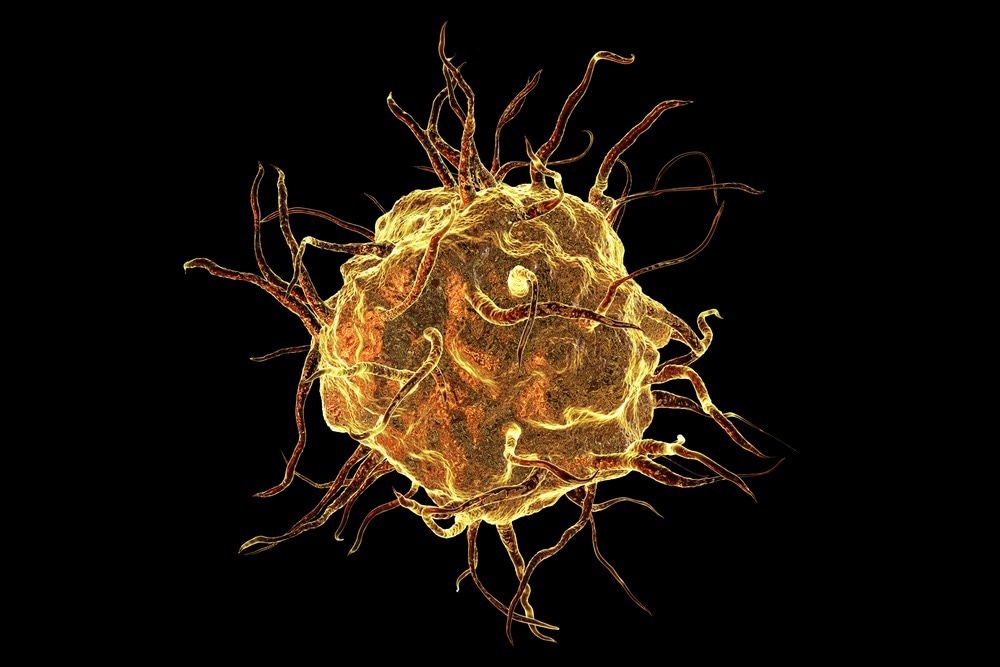The outstanding mechanical, electronic, and thermal properties of graphdiyne oxide nanosheets make them useful for biomedical applications. In nanotechnology-based biomedical applications, tumor-associated macrophage (TAM) serves as a potential cell population in cancer immunotherapy.

Study: Graphdiyne oxide nanosheets reprogram immunosuppressive macrophage for cancer immunotherapy. Image Credit: Kateryna Kon/Shutterstock.com
In an article recently published in the journal Nano Today, researchers observed that the polarization of M2-like macrophages with graphdiyne oxide nanosheets induced cancer cell apoptosis by activating the pro-inflammatory pathways. The intraperitoneally injected graphdiyne oxide suppressed tumor growth in the melanoma-containing animal model.
Additionally, graphdiyne oxide nanosheets activated cytotoxic T cells enhanced the response of a checkpoint inhibitor in a breast cancer mouse model. The team hypothesized that graphdiyne oxide triggered both innate and adaptive immune responses, improving the efficiency of cancer immunotherapy.
Role of Macrophages in Immunosuppression
Two-dimensional (2D) carbon materials have several applications in the biomedical field. Graphdiyne is 2D carbon material whose chemical structure is composed of sp, sp2 carbon atoms with a highly conjugated π-system. Graphdiyne-based materials are utilized in optical imaging, immunomodulation, drug delivery, and antimicrobial treatments.
Because of the unique chemical structure of graphdiyne, several cancer treatment strategies have been developed, including photothermal therapy (PTT), photodynamic therapy (PDT), catalytic therapy, and immunotherapy.
The tumor microenvironment (TME) plays a vital role in limiting the infiltration and functioning of CD8+ T cells, stimulating various cell cytokines to promote immunosuppression. Targeting the tumor immunosuppressive microenvironment could improve the outcome of cancer immunotherapy.
To this end, TAM serves as a convenient cell population to target. In a TME, the TAMs promote tumor progression from immunosuppression to metastasis which restrains clinical therapeutics.
Macrophages possess the memory to transform from a pro-tumor M2-like phenotype (termed TAMs) to an anti-tumor M1-like phenotype, which secretes cytotoxic chemical species like reactive nitrogen, oxygen, and pro-inflammatory cytokines to suppress tumor growth. Although several small molecule drugs reached clinical trials, the target-specificity was limited in these drugs. Owing to their unique physicochemical properties nanoplatforms, they are tested clinically for chemotherapeutic applications.
Previous studies revealed that graphdiyne oxide nanosheets could reverse the immunosuppressive M2 macrophages into pro-inflammatory M1 macrophages by inactivating signal transduction and suppressing transcription protein (STAT3) activator. Furthermore, previously reported experimental studies revealed that the protein corona formed on the surface of nanoplatforms affected the macrophage phenotype outcome.
Graphdiyne Oxide Nanosheets Towards Cancer Immunotherapy
In the present study, isotope quantification technology, proteomics, and the immune cell-depletion animal model were used to investigate the mechanism of tumor suppression and understand the role of macrophages in tumor therapy.
Proteomic analysis revealed that graphdiyne oxide nanosheets-mediated macrophage polarization could be possible via interleukin-1 (IL-1) processing, mitogen-activated protein kinase (MAPK) pathway, and toll-like receptor (TLR) signaling pathways. However, these polarizations activated cytotoxic T cells.
This proteomic analysis evaluated the protein expression in both graphdiyne and graphdiyne oxide nanosheets-treated macrophages, which revealed the expression of 68 proteins.
The increased expression of phosphorylation of c-Jun amino-terminal kinases (JNK) and extracellular signal-regulated kinase (Erk p38) confirmed that graphdiyne and graphdiyne oxide nanosheets-induced MAPK pathway activation. The Western blot analysis indicated that graphdiyne and graphdiyne oxide nanosheets invoked the expression of myeloid differentiation primary response 88 (MyD88), phosphorylated nuclear factor kappa-light-chain-enhancer of activated B cells (NF-κB), and phosphorylated ikappaB kinase (iκB-а), which confirmed the activation of the TLR pathway.
Followed by the internalization of graphdiyne oxide nanosheets, the flow cytometry analysis showed high CD86+ cells (classical M1 marker) and reduced CD206+ cells (classical M2 marker). These results suggest that graphdiyne oxide nanosheets could be capable of polarizing the macrophages. Furthermore, on the administration of graphdiyne oxide nanosheets, the flow cytometry showed a decreased expression in CD206 biomarker, Ym1 (eosinophilic chemotactic factor), and arginine mRNA expression.
Graphdiyne oxide nanosheets could kill the tumor cells via stimulation of the pro-inflammatory signaling pathways, which re-educate the TAMs and increase T cell infiltration.
Conclusion
In summary, nanomaterials-based immune system manipulations are efficient strategies for cancer treatment. The developed 2D graphdiyne and graphdiyne oxide nanosheets had a high surface-to-volume ratio that offered a broad nano-bio interface with outstanding electrocatalytic activity. Moreover, heterogeneous electron transfer capacity in these nanomaterials provided new information on the biological effect of manipulations.
The graphdiyne oxide nanosheets re-educated TAMs and impaired the tumor immunosuppressive microenvironment. Moreover, graphdiyne oxide nanosheets showed some degree of efficiency in sensitizing the tumor environment, suggesting its potential for effective combination therapy.
In the future, the team anticipates clarifying the T cell activation mechanisms. Due to the immunosuppressive microenvironment, breast cancer remains resistant to T-cell-based immunotherapies. Thus, graphdiyne oxide nanosheets were used in the present study to reverse the immune suppression environment. Consequently, graphdiyne oxide nanosheets treatment leveraged the ability of T cells and macrophages to improve the immune checkpoint blockade efficacy.
Reference
Guo, M., Liu, J., Chen, X., You, Z., Gao, F., Liu, T., Ren, J et al. (2022). Graphdiyne oxide nanosheets reprogram immunosuppressive macrophage for cancer immunotherapy. Nano Today
https://www.sciencedirect.com/science/article/pii/S1748013222001712?via%3Dihub
Disclaimer: The views expressed here are those of the author expressed in their private capacity and do not necessarily represent the views of AZoM.com Limited T/A AZoNetwork the owner and operator of this website. This disclaimer forms part of the Terms and conditions of use of this website.